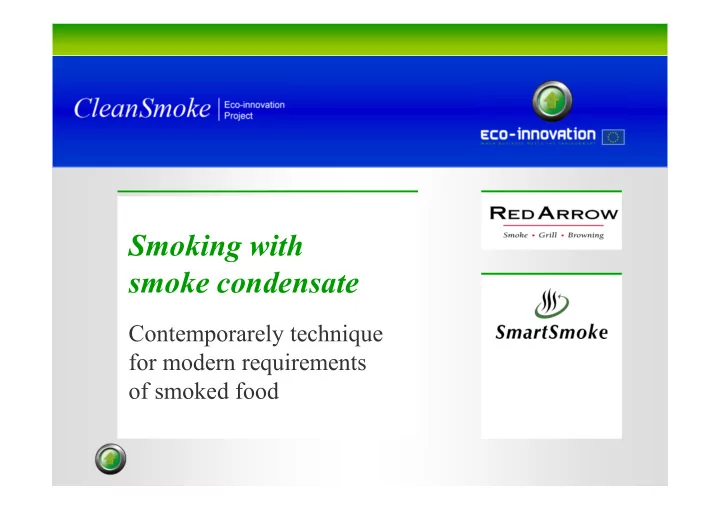

Smoking with smoke condensate Contemporarely technique for modern requirements of smoked food
Overview • Smoking – a traditional process – Smoking methods in comparison – Consideration of environment • Manufacturing and characterization of smoke condensates • Smoking with smoke condensates: – Tarber Smoke Master – smoke generation – SmartSmoke - cold smoking technology • Benefits for the consumer • Conclusion
Smoking – a traditional process
Direkt smoking with sawdust
Indirect smoking – combustion smoke
Indirect smoking – friction smoke
Indirect smoking – steam smoke
Indirect smoking – smoke condensate
Worst case scenarios
Disposal of ashes
Installation example – smoke condensate
Environmental analysis (e.g. France)
Smoking with freshly generated smoke 3.000 t Sawdust Heat 480 t Tar Smoke 960 t Ashes Smokehouse 87 t 1.440 t Cleaning detergent Pollution into environment
Smoking with purified smoke 3.000 t Sawdust Heat 99,75 % Tar recycled 7.7 t Ashes as raw material for road construction 99,75 % Ashes recycled Smoke 18 t Smoke condensate Smokehouse Cleaning detergents
Red Arrow production facilities Manitowoc, WI Rhinelander, WI Production Facility Production Facility Manitowoc, WI Distribution Center
Red Arrow smoke generator
Manufacturing process of Red Arrow smoke condensates • Ingredients: freshly generated smoke from sawdust, water • 60 % less wood consumption for the equal quantity of smoke • Charcoal and tar at 99,75 % transferred to energy • No wastewater • No smoking emissions • Burning gases filtered via biofilter
Facts about smoke generation Facts: 100 % Sawdust � 32 % Ashes � 16 % Tar � 52 % Smoke
Characterization of smoke condensates • Content of acids • Content of phenols / spectrum of phenols • Content of carbonyls • Density / Viscosity • pH-value • Benzo(a)pyrene- content • Others
EFSA report concerning PAHs in food items from June 29th, 2007 Table 20: The influence of smoke generation method on BaP Concentrations. Table 21: The influence of smoke distribution source on BaP Concentrations. Where ”N” is the number of samples tested. Median and P95 values may be found in the full EFSA report page 25 & 26. Note: The current EFSA maximum allowable limit for BaP is 5.0 µg/kg. This limit may be lowered to 1.0 µg/kg.
The impacts of smoke • Smoke colour (carbonyls) • Smoke falvour (phenols) – taste – Smell • Texture (phenols, acids) • Preservation – microbiological (acids, phenols) – antioxidative (phenols)
Smoke generation with Tarber Smoke Master Partikelgrößenverteilung ohne Umluft Partikelgrößenverteilung ohne Umluft 25,00 25,00 Verteilung in % Verteilung in % 20,00 20,00 15,00 15,00 10,00 10,00 5,00 5,00 0,00 0,00 0,10 0,10 1,00 1,00 10,00 10,00 100,00 100,00 1.000,00 1.000,00 Partikeldurchmesser in µm Partikeldurchmesser in µm
Distribution of particles: atomization without circulation fan Partikelgrößenverteilung ohne Umluft Partikelgrößenverteilung ohne Umluft 85% < 1,00 µm 98% < 5,00 µm µm 25,00 25,00 100% < 57,00 µm Verteilung in % Verteilung in % 20,00 20,00 15,00 15,00 10,00 10,00 5,00 5,00 0,00 0,00 0,10 0,10 1,00 1,00 10,00 10,00 100,00 100,00 1.000,00 1.000,00 Partikeldurchmesser in µm Partikeldurchmesser in µm
Facts for the optimal distribution of particles • Special calibrated atomizing nozzles • Flow – max. 5 l/h per nozzle • Exactly controlled air presure at nozzle – min. 5,5 bars per nozzle • Stopping circulation fan during atomization • High concentrated smoke condensates • Smoke condensates with low viscosity – < 20mPa*s • Exactly controlled atomization intervals • Quantity of generated smoke
Paratmeters with influence to smoke generation • Smoke density – atomization intervals – flow of smoke condensate (l/h ) • Temperature • Relative humidity • Fan speed • Time
Smokehouse requirements • Dampers for fresh air intake and exhaust must be able to close during smoking process • No leakages in smokehouse (e.g. door sealings) • No steam inlet into closed smokehouse (e.g. moiturization, heating system) • Equal temperature distribution in smokehouse • Temperature and humidity control must exist • Air pressure of at least 7,0 bars must exist • Air flow of 200 l/min per nozzle (dry, no particles and oil-free)
SmartSmoke – cold smoking technology www.CleanSmoke.info
External smoke generator Start Video Fully automated (type with TG-1200 MS )
Installation example / operating mode
Your benefits • Coventional smoking process will be exchanged • Smoke quantity is exactly dosed • Less dirt (tar, ashes) in smokehouses • Reduced need for cleaning detergents • No tar, no ashes, no fire • No explosion hazard • Healthier food products • Constant product quality • Smoking process without emissions
Excellent smoke quality • New smoke quality seal – Differentiation from competition – Focus on consumers´ need protected brand label
Benefits for consumers
Benefits for consumers • Healthier food, no toxic substances (e.g. PAH4, 3-MCPD) • Increased product safety, because smoke is generated under control, purified and applicated in the exact quantity needed • Reduction of CO 2 emissions up to 80% compared to combustion smoke • Minimized wastewater contamination, less water consumption, less need for cleaning detergents, no ashes, no tar • Protection of resources, reduced need for wood • Controlled smoke quality by exactly quided manufacturing process of smoke condensates • Taste variety by the use of different wood species (e.g. oak, beech, maple, cherry tree, apple tree, hickory, pine-tree), means a larger product range to choose from � Constant quality of smoked products
Conclusion The use of regenerated smoke for smoking processes provides the possibility of bringing cost efficiency , ecological awareness and safety thinking in line and puts the consumers need for trust and healthy nutrition in the focus at the same time.
Thank you for your attention! Your partner for innovative smoking technology
Recommend
More recommend